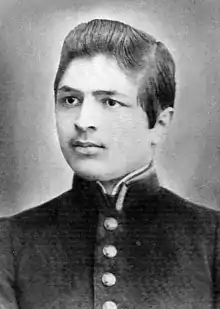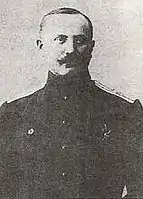Mountainous Republic of the Northern Caucasus
The Mountainous Republic of the Northern Caucasus (MRNC; also known as the Mountain Republic or the Republic of the Mountaineers) was a country in the North Caucasus formed by the unification of Circassians, Chechens, Ingush, Ossetians and Dagestanis proclaimed at the congress of the North Caucasian peoples on May 1, 1917. It lived from 1917 until 1922.
The Mountainous Republic of the Northern Caucasus | |||||||||
|---|---|---|---|---|---|---|---|---|---|
| 1917–1922 | |||||||||
 Flag
 Coat of arms
| |||||||||
 | |||||||||
| Capital | Temir-Khan-Shura (now Buynaksk) | ||||||||
| Common languages | Russian · Chechen Ingush · Ossetic Kabardian · Dagestani languages | ||||||||
| Religion | Islam (Majority and state-backed faith) Russian Orthodox Church (Minority) | ||||||||
| Government | Federal republic | ||||||||
| Legislature | Parliamentary | ||||||||
| Historical era | World War I · Interwar period | ||||||||
• Independence declared | 6 March 1917 | ||||||||
• Replaced by Mountain Autonomous Soviet Socialist Republic | 30 November 1922 | ||||||||
| Area | |||||||||
• Total | 414,655 km2 (160,099 sq mi) | ||||||||
| Population | |||||||||
• 1920 census | 11,000,000 | ||||||||
| Currency | Tumen | ||||||||
| |||||||||
MRNC included most of the territory of the former Terek Oblast and Dagestan Oblast of the Russian Empire, which now form the republics of Chechnya, Ingushetia, North Ossetia–Alania, Kabardino-Balkaria, Dagestan, Abkhazia and part of Stavropol Krai of the Russian Federation. The total land area was about 414,655 square kilometers (160,099 sq mi), with a population of about 11 million. Its capital was initially at Vladikavkaz, then Nazran, and finally Temir-Khan-Shura.
It broke away from the Russian Empire during the February Revolution, shortly before the start of the Russian Civil War. The state was captured by Soviet Russian forces in 1921, who transformed it into the Mountain Autonomous Soviet Socialist Republic.[1]
State formation
The Union, included seven "states", allocated on a national basis and united according to a confederative principle in the territories: Dagestan, Ingushetia, Chechnya, Ossetia, Circassia (Including West Circassia but the union only had control over East Circassia), the Nogai steppes and also claims in Abkhazia, although the union never had direct control over the Abkhazian land.[2][3][4]
The Cabinet of Ministers of the Mountain Republic included representatives from almost all regions of the North Caucasus.
- Chairman of the Central Committee of the Union, then the first Prime Minister of the Republic - Abdul Majid Tapa Chermoev (from Chechnya);
- Second Prime Minister - Pshemakho Kotsev (from Circassia);
- Minister of Posts and Telegraph - Ibrahimbek Gaydarov (from Dagestan);
- Minister of Internal Affairs and Second Chairman of the Central Committee of the Union - Rashitkhan Kaplanov (from Dagestan);
- Minister of Foreign Affairs - Gaidar Bammat (from Dagestan);
- Minister of War - Nukh-Bek Tarkovsky (from Dagestan);
- Minister of Finance, author of the Declaration of Independence and the Constitution of the Mountain Republic- Vassan-girey Dzhabagiev (from Ingushetia).
History

The Union of the Peoples of the Northern Caucasus was created in March 1917, and an Executive Committee of the Union was elected. The Chairman of the Executive Committee was one of the leaders of the National‐Liberation movement of the Peoples of the Northern Caucasus, Tapa Tchermoeff. The 1847 "Nizam" (constitution) of Imam Shamil was re-adopted on 5 August 1917 by the Central Committee of the Northern Caucasus. The republic was officially established on 11 May 1918, after the collapse of the Russian Tsarist empire in the Russian revolution of 1917, when the government of the MRNC was established. The main founders of the MRNC included Said Shamil (grandson of Imam Shamil, who in 1924 would become a founder and leader of the Committee of Independence of the Caucasus in Weimar Germany), Prime Minister Tapa Tchermoeff, Ali-Khaji Akusha and Haidar Bammate. The Republic's capital was Temir-Khan-Shura.
The Mountainous Republic was de jure recognized by the Ottoman Empire, Germany, the Azerbaijan Democratic Republic, Armenia, the Democratic Republic of Georgia, Ukraine, Bulgaria, Belarus, Latvia, Estonia, France, Finland, United Kingdom of Great Britain and Ireland, United States, Italy, Austria-Hungary, Poland, Don Republic, Japan, and the Kuban People's Republic.

During the Russian Civil War, MRNC soldiers engaged in fierce clashes against the invading White troops of General Anton Denikin's Volunteer Army. The fighting ended in January 1920, when Denikin's army was completely defeated by the 11th Red Army. The advancing Red Army was at first greeted with red flags in the villages of the Northern Caucasus, but the promises of autonomous rule made by the Bolsheviks went unrealized.
In January 1921, the MRNC was occupied by the Red Army of Bolshevik Russia and the government of the republic was forced to leave the Caucasus. In January 1921, the Soviet Mountain Republic of the Russian SFSR was established.
Some government members 1917—1919
 Abdul-Medjid Tapa Tchermoeff — oil industrialist, first Central Committee chairman and first prime minister, Chechen. Died in Paris in 1937.
Abdul-Medjid Tapa Tchermoeff — oil industrialist, first Central Committee chairman and first prime minister, Chechen. Died in Paris in 1937. Rashit khan Kaplanov, second Central Committee chairman, Minister of Internal Affairs, Kumyk. Killed by Bolshevik government in 1937.
Rashit khan Kaplanov, second Central Committee chairman, Minister of Internal Affairs, Kumyk. Killed by Bolshevik government in 1937. Pshemakho Kotsev, second prime minister, Circassian. Died in Istanbul in 1962.
Pshemakho Kotsev, second prime minister, Circassian. Died in Istanbul in 1962. Haidar Bammate, Foreign Minister, Kumyk. Died in Paris in 1965
Haidar Bammate, Foreign Minister, Kumyk. Died in Paris in 1965 Nukh-bek Tarkovskiy, Military Minister, Kumyk. Died in Switzerland in 1951.
Nukh-bek Tarkovskiy, Military Minister, Kumyk. Died in Switzerland in 1951. Zibair Temirkhanov, Madjlis (Parliament) Chairmen, Kumyk. Twice repressed by Bolsheviks, died in 1952 in Dagestan.
Zibair Temirkhanov, Madjlis (Parliament) Chairmen, Kumyk. Twice repressed by Bolsheviks, died in 1952 in Dagestan.
 Alikhan Kantemir, official representative in neighbouring countries (Azerbaijan, Georgia), Muslim Ossetian. Died in Munich in 1963.
Alikhan Kantemir, official representative in neighbouring countries (Azerbaijan, Georgia), Muslim Ossetian. Died in Munich in 1963.
See also
 History portal
History portal- Caucasian Imamate (1828–1859)
- North Caucasian Soviet Republic (1918)
- Mountain Autonomous Soviet Socialist Republic (1921-1924)
- Confederation of Mountain Peoples of the Caucasus (1989–2000)
- Prometheism
Notes
- World, Abkhaz. "Abkhazia, Georgia and the Caucasus Confederation, by Stanislav Lakoba". Abkhaz World | History, Culture & Politics of Abkhazia. Retrieved 2020-03-08.
- «После Февральской революции 1917 г. процесс политического самоопределения привел к образованию Карачаево-Балкарского штата в составе горской республики.» (ИЭА Российской академии наук. Серия энциклопедий «Народы и культуры», «Карачаевцы. Балкарцы.» — М.: Наука, ИЭА РАН, 2014. — С. 7. — 815 с. ISBN 978-5-02-038043-1.)
- Петр Михайлович Шаститко (2002). Обречённые догмы: большевизм и национальный вопрос. М.: Восточная литература. p. 44.
- Камалудин Гаджиев (2013). Кавказский узел в геополитических приоритетах России. Litres. ISBN 5457145670, 9785457145672 Check
|isbn=value: invalid character (help). - "Гайдаров Ибрагим-бек Исаббекович". www.hrono.ru. Retrieved 2021-02-03.
Bibliography
| Wikimedia Commons has media related to Mountainous Republic of the Northern Caucasus. |
- "Caucasian Republic Mission to the Peace Conference Appeal for Help", The Morning Post, London, Friday 4 April 1919.
- J. "Obedinennyi Kavkaz" ("Vereinigtes Kaukasien"), 1–3 (30–32), München, 1954. (in Russian)
- Baddeley, J. F., 1908, The Russian Conquest of the Caucasus, Longmans, Green, and Co., London
- Madeleine Henrey, Madeleine Grown Up, J. M. Dent & Sons, London, 1954.
- Kathleen R. Jackson, Marat Fidarov, Essays on the History of the North Caucasus, HHN Media, New York, 2009.
- Marshall, Alex (2010), The Caucasus Under Soviet Rule, New York City: Routledge
- Saparov, Arsène (2015), From Conflict to Autonomy in the Caucasus: The Soviet Union and the making of Abkhazia, South Ossetia and Nagorno Karabakh, New York City: Routledge
- Storozhenko (ed.), Ingushetia and Chechen Republic Map, Northern Caucasian Aerogeodesic Company of Roskartografia, Russia, 1995.
- Levan Z. Urushadze, "About the history of the question of unity of the Caucasian Peoples". J. "Amirani", XIII, Montreal‐Tbilisi, 2005, pp. 72–87.
- «Союз горцев Северного Кавказа и Горская республика. История несостоявшегося государства. 1917-1920», М.М. Вачагаев, 2018